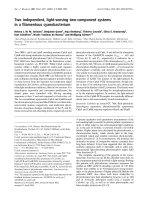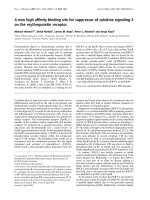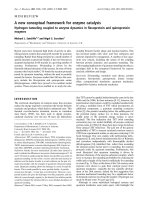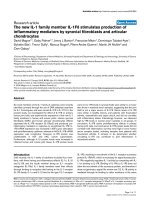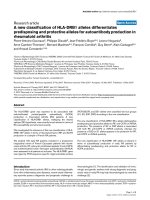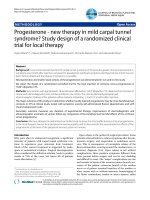Báo cáo y học: "Porin new light onto chromatin and nuclear organization" ppsx
Bạn đang xem bản rút gọn của tài liệu. Xem và tải ngay bản đầy đủ của tài liệu tại đây (149.74 KB, 4 trang )
Genome
BBiioollooggyy
2008,
99::
222
Minireview
PPoorriinn nneeww lliigghhtt oonnttoo cchhrroommaattiinn aanndd nnuucclleeaarr oorrggaanniizzaattiioonn
Lee E Finlan and Wendy A Bickmore
Address: MRC Human Genetics Unit, Institute of Genetics and Molecular Medicine, University of Edinburgh, Crewe Road, Edinburgh,
EH4 2XU, UK.
Correspondence: Lee E Finlan. Email: ; Wendy A Bickmore Email.
AAbbssttrraacctt
A recent report identifies sites in the human genome that can associate with nucleoporin 93, a
subunit of the nuclear pore complex. These associations are modulated by levels of global histone
acetylation and highlight the dynamic nature of chromatin organization in the nucleus.
Published: 16 May 2008
Genome
BBiioollooggyy
2008,
99::
222 (doi:10.1186/gb-2008-9-5-222)
The electronic version of this article is the complete one and can be
found online at />© 2008 BioMed Central Ltd
Nuclear pore complexes (NPCs) in the nuclear envelope
mediate the selective exchange of macromolecules into and
out of the nucleus by facilitated diffusion. The NPC is com-
posed of multiple copies of roughly 30 distinct nucleoporins
[1-3] and its structure is conserved throughout eukaryotes.
Although numerous studies have examined how nucleoporins
function in nucleo-cytoplasmic transport, relatively little
attention has been paid to any role they might have in
influencing genome organization in mammalian cells.
The nuclear periphery has customarily been associated with
inactive chromatin structure and with the repression of gene
expression [4-7]. Evidence for a more complex relationship
between gene activity and the nuclear periphery, linking the
upregulation of gene expression with the association of
chromatin with the NPC, came initially from studies in
budding yeast (Saccharomyces cerevisiae) and Drosophila
[8,9]. Now, a recent report in Genes & Development from
Pamela Silver and her colleagues (Brown et al. [10]) shows,
by chromatin immunoprecipitation (ChIP), that physical
associations between the nucleoporin NUP93 and specific
regions of human chromosomes can be captured, and
moreover that the inhibition of histone deacetylases (HDACs)
leads to altered genomic associations with this nucleoporin.
CCaappttuurriinngg nnuucclleeooppoorriinn cchhrroommaattiinn aassssoocciiaattiioonnss
NUP93 is the most abundant nucleoporin and is essential for
NPC assembly and function [11]. It is a very stable and
centrally located component of the NPC, giving confidence
that any interactions between it and chromatin do indeed
occur at the nuclear periphery rather than being due to free
nucleoplasmic protein [12]. The Silver lab had previously
shown by ChIP that various components of the yeast NPC,
including Nic96, the yeast homolog of NUP93, could asso-
ciate with specific regions of the yeast genome [13]. They
have now extended this approach to regions of three
different human chromosomes that interact with NUP93 in
HeLa cells [10]. After cell fixation with dimethyl adipimidate
and paraformaldehyde, lysis in detergent and then sonica-
tion, DNA sequences associating with NUP93 in the soluble
extract were captured by ChIP, amplified, and hybridized to
a tiling microarray covering chromosomes 5, 7 and 16. A
total of 207 associated regions, significantly enriched in the
ChIP material relative to control (input) chromatin, were
defined. For some selected loci, their disposition at, or
adjacent to, the nuclear periphery was confirmed by fluores-
cence in situ hybridization (FISH).
The chromosomal distribution of the NUP93-associated
regions was not random. Such sites were enriched in the G-
bands and depleted from the more gene-rich R-bands,
consistent with the known polar organization of chromosomes
in the nucleus, with G-bands tending to be concentrated at the
periphery [14]. By comparison with published genome-wide
distributions of histone methylation states in CD4 T cells [15],
NUP93-associated regions were those typically enriched for
histone H3 methylation marks that correlate with inactive
chromatin (trimethylation on H3 lysine 9 (H3K9me3), lysine
27 (H3K27me3), or lysine 79 (H3K79me3)), and depleted in
signatures of active genes and RNA polymerase II.
Chromatin at the nuclear periphery is generally hypoacety-
lated, but this can be altered by the inhibition of HDACs
with trichostatin A (TSA) [16,17]. This treatment is sufficient
to upregulate genes whose expression has been suppressed
as a consequence of tethering at the nuclear periphery [7].
After treating HeLa cells for 12 hours with TSA, Brown et al.
[10] found that NUP93 associations captured on the three
analyzed chromosomes were substantially altered, with fewer
(170) associated regions, indicating a dynamic shift in NPC-
chromatin interactions in the presence of raised levels of
histone acetylation.
Indeed, compared with the untreated cells, Brown et al. [10]
saw an overall shift in the NUP93-associated sequences
towards transcriptional start sites and regions of the genome
thought to be marked with histone modifications typical of
transcriptionally active regions (such as H3K4 methylation)
and enriched in RNA polymerase II [15]. However, they
made no analysis of chromatin structure in the TSA-treated
HeLa cells, and it will be interesting to see how the histone
methylation marks are altered when chromatin is
hyperacetylated with TSA under the experimental conditions
used in this study.
In some cases, changes in NUP93 association appear to be
quite local. In one characterized example from chromosome
7, NUP93 association, previously thought to be in a purely
intergenic region but actually including the 5’ end of a
recently annotated transcription unit (Figure 1a), then
extended out to the transcription start sites of two additional
flanking genes in TSA-treated cells. Expression of one of
these flanking genes was upregulated in the TSA-treated
cells, but the expression of the other was unaffected.
More generally, the changes in NUP93 association caused by
TSA treatment seem to be long range, as the overall chromo-
somal distribution of associated regions shifted away from
G-bands and toward R-bands (Figure 1b). This scale of
genome reorganization should be detectable at the cyto-
logical level, and indeed, relocalization of loci either towards
or away from the nuclear periphery was detected by FISH in
TSA-treated cells. One of the loci whose association with
NUP93 was diminished by TSA treatment was the cystic
fibrosis transmembrane conductance regulator (CFTR) locus
at 7q31.2 (Figure 1b). This is consistent with a previous study
in which CFTR was observed to move away from the nuclear
periphery upon TSA treatment [18]. Such large-scale spatial
reorganization of the sequences at the nuclear periphery is
also consistent with the changes observed in sequences
interacting with the nuclear lamina in TSA-treated Droso-
phila cells [5].
LLiinnkkiinngg hhiissttoonnee aacceettyyllaattiioonn ttoo nnuucclleeaarr rreeoorrggaanniizzaattiioonn
What might be the mechanisms by which TSA alters the
association between chromatin and the nuclear periphery?
Chromatin decondensation, and hence enhanced chromatin
flexibility and mobility, as a consequence of the hyper-
acetylation induced by TSA, might account for the localized
changes in NUP93-chromatin associations. However, given
the constraints on chromatin motion in human cells [19], it
seems unlikely that this could account for the altered long-
range landscape of NUP93-associated regions after TSA
treatment. Instead, it is more likely that components of the
nuclear periphery have an affinity for chromatin marked
/>Genome
BBiioollooggyy
2008, Volume 9, Issue 5, Article 222 Finlan and Bickmore 222.2
Genome
BBiioollooggyy
2008,
99::
222
FFiigguurree 11
Effects of TSA on genomic regions associated with NUP93 in human cells.
((aa))
Short-range changes in NUP93-associated regions that result from
treatment with TSA (- and + TSA) are shown for a region of chromosome 7p (7p21.3). The associated regions are indicated as grey blocks in the lower
part of the figure. The locations of the three genes present in 7p21.3 are indicated. Map data are from the March 2006 assembly (hg18) of the human
genome. NUP93-associated sites, corresponding to the 5’ and upstream regions of the gene
AK027125
in untreated controls, are broadened in TSA-
treated cells to include the 5’ ends of the flanking genes
RPA3
(whose expression is unchanged by TSA), and
GLCCI1
(whose expression is upregulated
by TSA).
((bb))
Long-range changes in NUP93-associated regions that result from treatment with TSA are shown for a region of chromosome 7q. Grey and
black regions on the chromosome indicate cytogenetic bands (G-band, black; R-band, grey). The blue and black bands under the chromosome indicate
the positions of genes, as indicated to the left of the figure. Map data are from the March 2006 assembly (hg18) of the human genome. Adapted from [10].
50 kb
+TSA
–TSA
(b)(a)
50,000 kb
7p21.3
RPA3
GLCCl1
AK027125
Genes
NUP93-
associated
regions
7q31.317q31.27q31. 17q22.1
CFTR
with specific histone modifications, histone variants, or
other chromatin-associated proteins, and that TSA, by
hyperacetylating chromatin and other proteins, modifies
these interactions. In that case, the TSA-induced changes in
NPC-chromatin association might well require passage
through mitosis, as do other documented cases of large-scale
nuclear reorganization with respect to the nuclear periphery
[6,19,20].
As well as altering chromatin structure and organization,
TSA also induces the nuclear redistribution of nuclear
transport proteins and the histone acetyltransferase CBP,
which can interact with NUP93 [21], and it is unclear what
role these proteins might have in the altered NUP93-genome
associations reported in response to TSA.
In budding yeast, Nic96 (NUP93) association is found with
highly transcribed genes that contain the binding sites for a
particular transcriptional regulator [13] and there are several
examples in this organism that link the activation of gene
expression with nuclear pore association [8,9]. In the current
study in human cells [10] there was no statistically evident
overlap between NUP93 association and genes that are either
activated or repressed in response to TSA treatment.
This first report of specific genome interactions captured
by ChIP with a mammalian NPC component should
stimulate further investigations of the complex landscape
at the nuclear periphery and the role this might play in
regulating genome organization and function. Given that
the diameter of the central channel through the nuclear
pore is approximately the same as that of the 30-nm
chromatin fiber, it seems unlikely that substantial amounts
of chromatin find their way into the center of the nuclear
pore. Rather, given the extent of cross-linking used before
ChIP, it is likely that the associations captured by anti-
NUP93 ChIP are indirect. Hence, it will be important to
define exactly which components of the NPC provide the
chromatin-binding domains. One way to investigate this,
independently of ChIP, is the complementary approach of
expressing NPC components fused to the DAM
methyltransferase (DAM-ID), which has been used to
identify lamin-interacting sites in Drosophila [5].
It will also be of interest to investigate how nuclear pore-
genome associations are altered after treatment with TSA for
brief periods of time (less than 4 hours) that are sufficient to
induce bulk histone hyperacetylation and to relieve the
transcriptional suppression of genes tethered at the nuclear
membrane [7] but not long enough to allow cells to pass
through mitosis or to induce large-scale relocalization of
inactive chromatin away from the nuclear periphery [22]. It
will also be important to establish, by specific knockdown of
protein expression by short interfering RNAs, for example,
whether inhibition of any particular HDAC is critical for the
altered genomic association with the nuclear pores.
Finally, it remains to be resolved whether nuclear pore
associations with chromatin do have a direct role in inducing
gene expression in mammalian cells. The answer is likely to
be as complex as the question of whether association with
other components of the nuclear periphery can silence gene
expression [6,7], and indeed, given the complexities of mam-
malian genome organization and developmentally or physio-
logically induced changes in gene expression, we should not
expect simple black and white answers.
AAcckknnoowwlleeddggeemmeennttss
LEF and WAB are supported by the James S McDonnell foundation and
the Medical Research Council (UK).
RReeffeerreenncceess
1. Beck M, Forster F, Ecke M, Plitzko JM, Melchior F, Gerisch G,
Baumeister W, Medalia O:
NNuucclleeaarr ppoorree ccoommpplleexx ssttrruuccttuurree aanndd
ddyynnaammiiccss rreevveeaalleedd bbyy ccrryyooeelleeccttrroonn ttoommooggrraapphhyy
Science
2004,
330066::
1387-1390.
2. Tran EJ, Wente SR:
DDyynnaammiicc nnuucclleeaarr ppoorree ccoommpplleexxeess:: lliiffee oonn tthhee
eeddggee
Cell
2006,
112255::
1041-1053.
3. Cronshaw JM, Krutchinsky AN, Zhang W, Chait BT, Matunis MJ:
PPrrootteeoommiicc aannaallyyssiiss ooff tthhee mmaammmmaalliiaann nnuucclleeaarr ppoorree ccoommpplleexx
J Cell
Biol
2002,
115588::
915-927.
4. Shaklai S, Amariglio N, Rechavi G, Simon AJ:
GGeennee ssiilleenncciinngg aatt tthhee
nnuucclleeaarr ppeerriipphheerryy
FEBS J
2007,
227744::
1383-1392.
5. Pickersgill H, Kalverda B, de Wit E, Talhout W, Fornerod M, van
Steensel B:
CChhaarraacctteerriizzaattiioonn ooff tthhee
DDrroossoopphhiillaa mmeellaannooggaasstteerr
ggeennoommee
aatt tthhee nnuucclleeaarr llaammiinnaa
Nat Genet
2006,
3388::
1005-1014.
6. Reddy KL, Zullo JM, Bertolino E, Singh H:
TTrraannssccrriippttiioonnaall rreepprreessssiioonn
mmeeddiiaatteedd bbyy rreeppoossiittiioonniinngg ooff ggeenneess ttoo tthhee nnuucclleeaarr llaammiinnaa
Nature
2008,
445522::
243-247.
7. Finlan LE, Sproul D, Thomson I, Boyle S, Kerr E, Perry P, Ylstra B,
Chubb JR, Bickmore WA:
RReeccrruuiittmmeenntt ttoo tthhee nnuucclleeaarr ppeerriipphheerryy ccaann
aalltteerr eexxpprreessssiioonn ooff ggeenneess iinn hhuummaann cceellllss
PLoS Genet
2008,
44::
e1000039.
8. Brown CR, Silver PA:
TTrraannssccrriippttiioonnaall rreegguullaattiioonn aatt tthhee nnuucclleeaarr ppoorree
ccoommpplleexx
Curr Opin Genet Dev
2007,
1177::
100-106.
9. Akhtar A, Gasser SM:
TThhee nnuucclleeaarr eennvveellooppee aanndd ttrraannssccrriippttiioonnaall
ccoonnttrrooll
Nat Rev Genet
2007,
88::
507-517.
10. Brown CR, Kennedy CJ, Delmar VA, Forbes DJ, Silver PA:
GGlloobbaall
hhiissttoonnee aacceettyyllaattiioonn iinndduucceess ffuunnccttiioonnaall ggeennoommiicc rreeoorrggaanniizzaattiioonn aatt
mmaammmmaalliiaann nnuucclleeaarr ppoorree ccoommpplleexxeess
Genes Dev
2008,
2222::
627-639.
11. Jeudy S, Schwartz TU:
CCrryyssttaall ssttrruuccttuurree ooff nnuucclleeooppoorriinn NNiicc9966
rreevveeaallss aa nnoovveell,, iinnttrriiccaattee hheelliiccaall ddoommaaiinn aarrcchhiitteeccttuurree
J Biol Chem
2007,
228822::
34904-34912.
12. Rabut G, Doye V, Ellenberg J:
MMaappppiinngg tthhee ddyynnaammiicc oorrggaanniizzaattiioonn ooff
tthhee nnuucclleeaarr ppoorree ccoommpplleexx iinnssiiddee ssiinnggllee lliivviinngg cceellllss
Nat Cell Biol
2004,
66::
1114-1121.
13. Casolari JM, Brown CR, Komili S, West J, Hieronymus H, Silver PA:
GGeennoommee wwiiddee llooccaalliizzaattiioonn ooff tthhee nnuucclleeaarr ttrraannssppoorrtt mmaacchhiinneerryy
ccoouupplleess ttrraannssccrriippttiioonnaall ssttaattuuss aanndd nnuucclleeaarr oorrggaanniizzaattiioonn
Cell
2004,
111177::
427-439.
14. Sadoni N, Langer S, Fauth C, Bernardi G, Cremer T, Turner BM,
Zink D:
NNuucclleeaarr oorrggaanniizzaattiioonn ooff mmaammmmaalliiaann ggeennoommeess PPoollaarr cchhrroommoo
ssoommee tteerrrriittoorriieess bbuuiilldd uupp ffuunnccttiioonnaallllyy ddiissttiinncctt hhiigghheerr oorrddeerr ccoommppaarrtt
mmeennttss
J Cell Biol
1999,
114466::
1211-1226.
15. Barski A, Cuddapah S, Cui K, Roh TY, Schones DE, Wang Z, Wei G,
Chepelev I, Zhao K:
HHiigghh rreessoolluuttiioonn pprrooffiilliinngg ooff hhiissttoonnee mmeetthhyyllaattiioonnss
iinn tthhee hhuummaann ggeennoommee
Cell
2007,
112299::
823-837.
16. Taddei A, Maison C, Roche D, Almouzni G:
RReevveerrssiibbllee ddiissrruuppttiioonn ooff
ppeerriicceennttrriicc hheetteerroocchhrroommaattiinn aanndd cceennttrroommeerree ffuunnccttiioonn bbyy iinnhhiibbiittiinngg
dd
eeaacceettyyllaasseess
Nat Cell Biol
2001,
33::
114-120.
17. Gilchrist S, Gilbert N, Perry P, Bickmore WA:
NNuucclleeaarr oorrggaanniizzaattiioonn
ooff cceennttrroommeerriicc ddoommaaiinnss iiss nnoott ppeerrttuurrbbeedd bbyy iinnhhiibbiittiioonn ooff hhiissttoonnee
ddeeaacceettyyl
laasseess
Chromosome Res
2004,
1122::
505-516.
18. Zink D, Amaral MD, Englmann A, Lang S, Clarke LA, Rudolph C, Alt
F, Luther K, Braz C, Sadoni N, Rosenecker J, Schindelhauer D:
TTrraann
ssccrriippttiioonn ddeeppeennddeenntt ssppaattiiaall aarrrraannggeemmeennttss ooff CCFFTTRR aanndd aaddjjaacceenntt
ggeenneess iinn hhuummaann cceellll nnuucclleeii
J Cell Biol
2004,
116666::
815-825.
/>Genome
BBiioollooggyy
2008, Volume 9, Issue 5, Article 222 Finlan and Bickmore 222.3
Genome
BBiioollooggyy
2008,
99::
222
19. Thomson I, Gilchrist S, Bickmore WA, Chubb JR:
TThhee rraaddiiaall ppoossii
ttiioonniinngg ooff cchhrroommaattiinn iiss nnoott iinnhheerriitteedd tthhrroouugghh mmiittoossiiss bbuutt iiss eessttaabb
lliisshheedd ddee nnoovvo
o iinn eeaarrllyy GG11
Curr Biol
2004,
1144::
166-172.
20. Kumaran RI, Spector DL:
AA ggeenneettiicc llooccuuss ttaarrggeetteedd ttoo tthhee nnuucclleeaarr
ppeerriipphheerryy iinn lliivviinngg cceellllss mmaaiinnttaaiinnss iittss ttrraannssccrriippttiioon
naall ccoommppeetteennccee
J Cell
Biol
2008,
118800::
51-65.
21. Ryan CM, Harries JC, Kindle KB, Collins HM, Heery DM:
FFuunnccttiioonnaall
iinntteerraaccttiioonn ooff CCRREEBB bbiinnddiinngg pprrootteeiinn ((CCBBPP)) wwiitthh nnuucclleeaarr ttrraannssppoorrtt
pprrootteeiinnss aanndd mmood
duullaattiioonn bbyy HHDDAACC iinnhhiibbiittoorrss
Cell Cycle
2006,
55::
2146-2152.
22. Croft JA, Bridger JM, Boyle S, Perry P, Teague P, Bickmore WA:
DDiiff
ffeerreenncceess iinn tthhee llooccaalliizzaattiioonn aanndd mmoorrpphhoollooggyy ooff cchhrroommoossoommeess iinn tthhee
hhuummaann nnuucclleeuuss
J Cell Biol
1999,
114455::
1119-1131.
/>Genome
BBiioollooggyy
2008, Volume 9, Issue 5, Article 222 Finlan and Bickmore 222.4
Genome
BBiioollooggyy
2008,
99::
222


